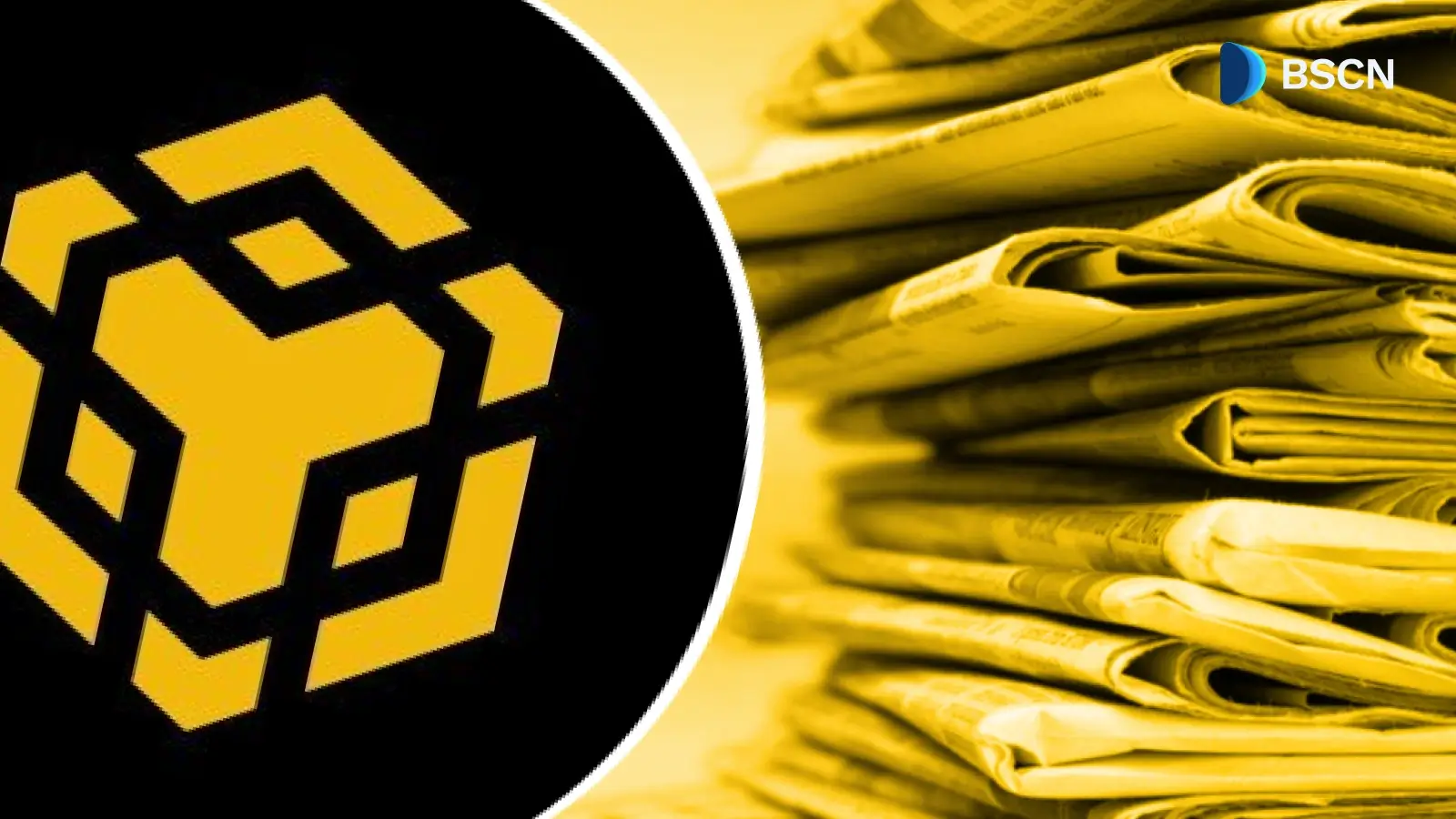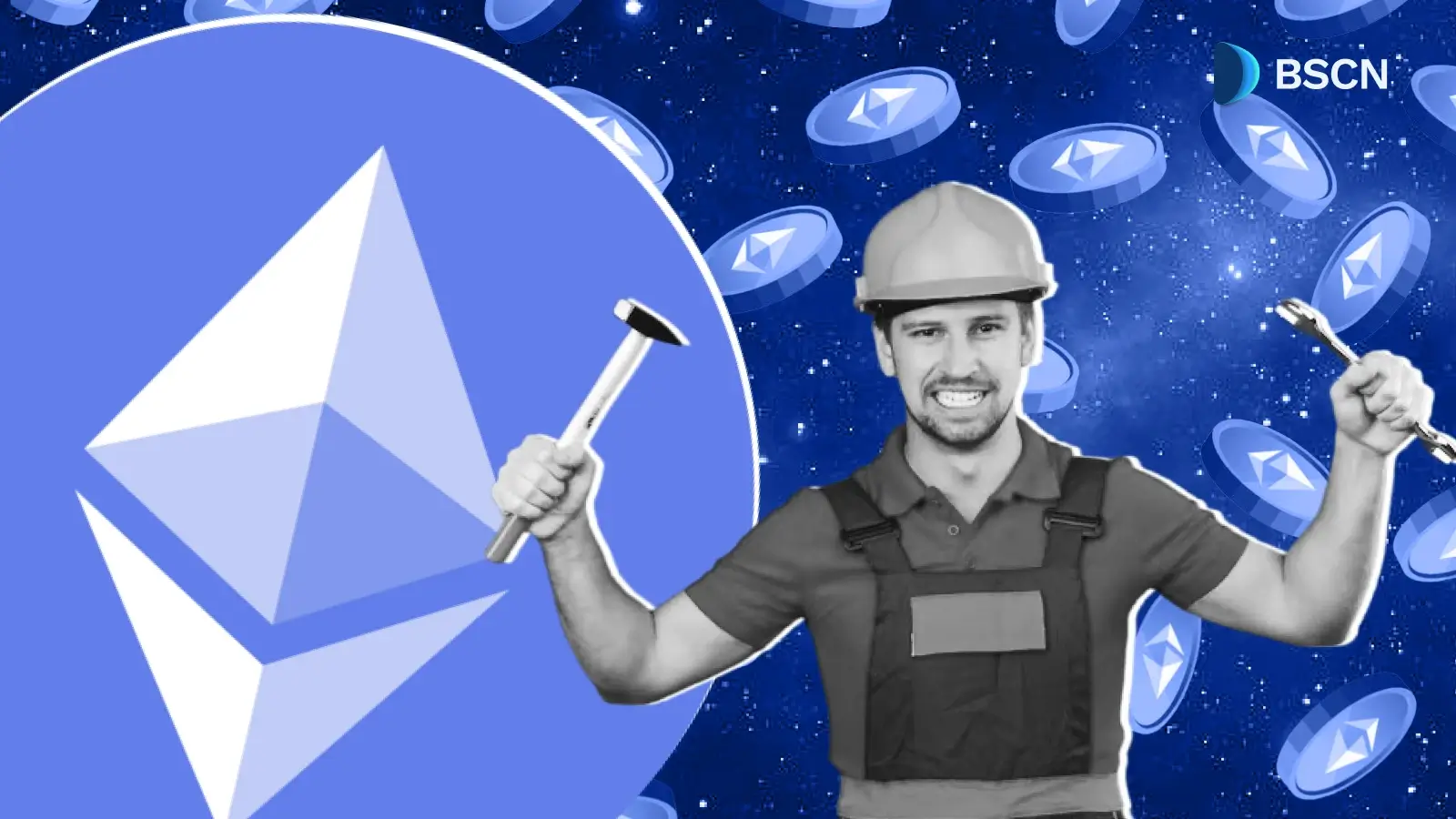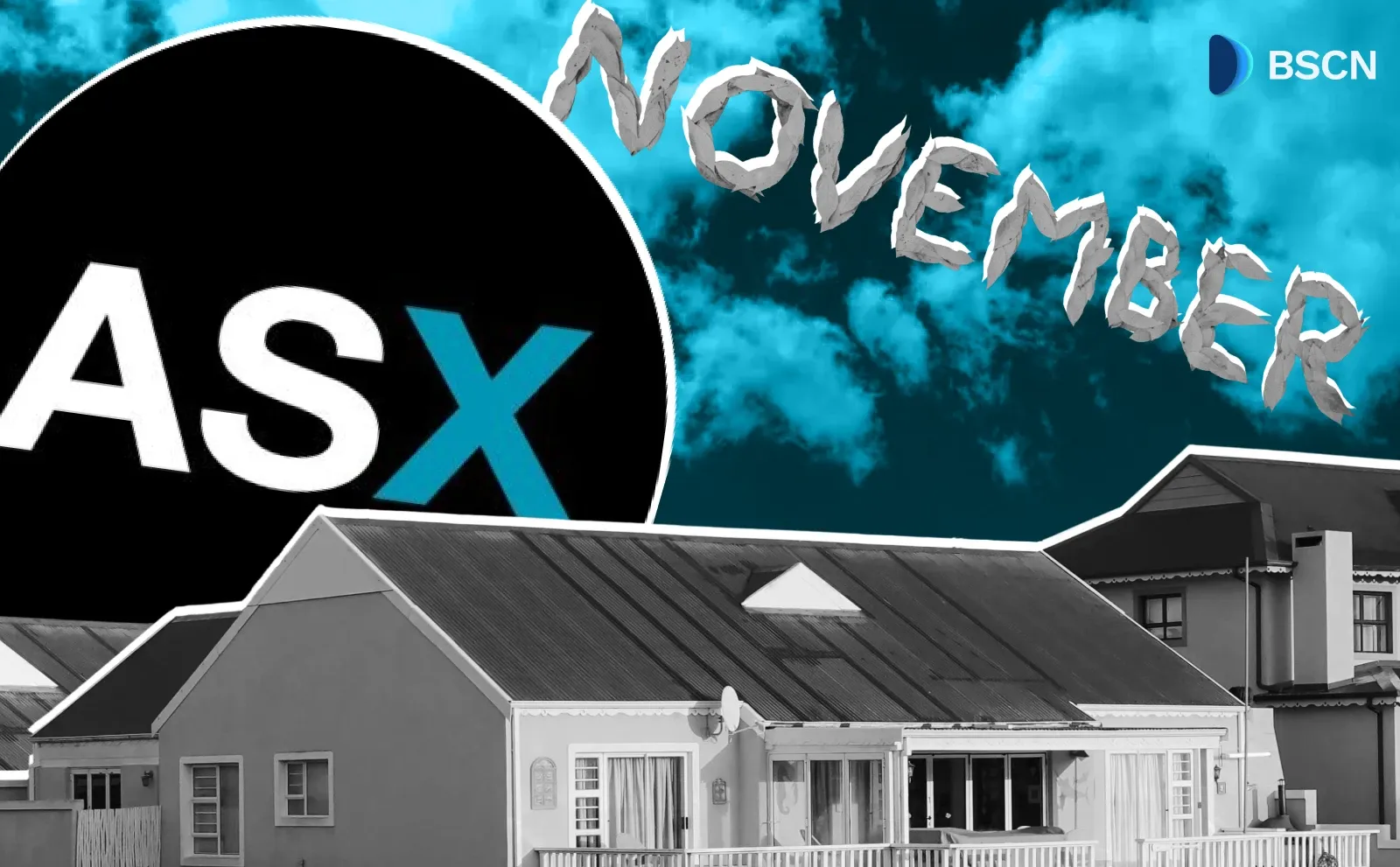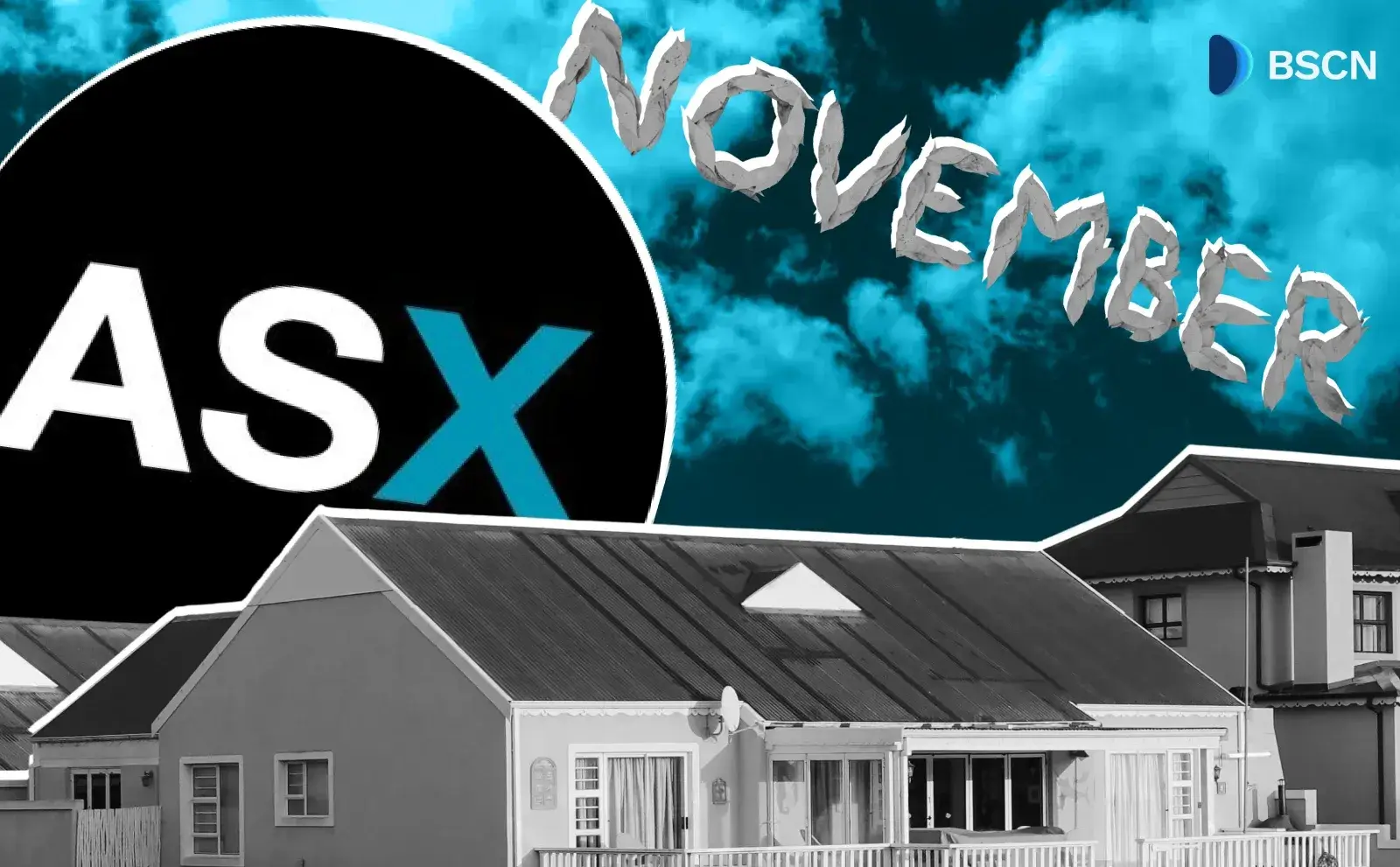Deepdive
(Advertisement)
What is Kava Chain & the KAVA Token? Explained
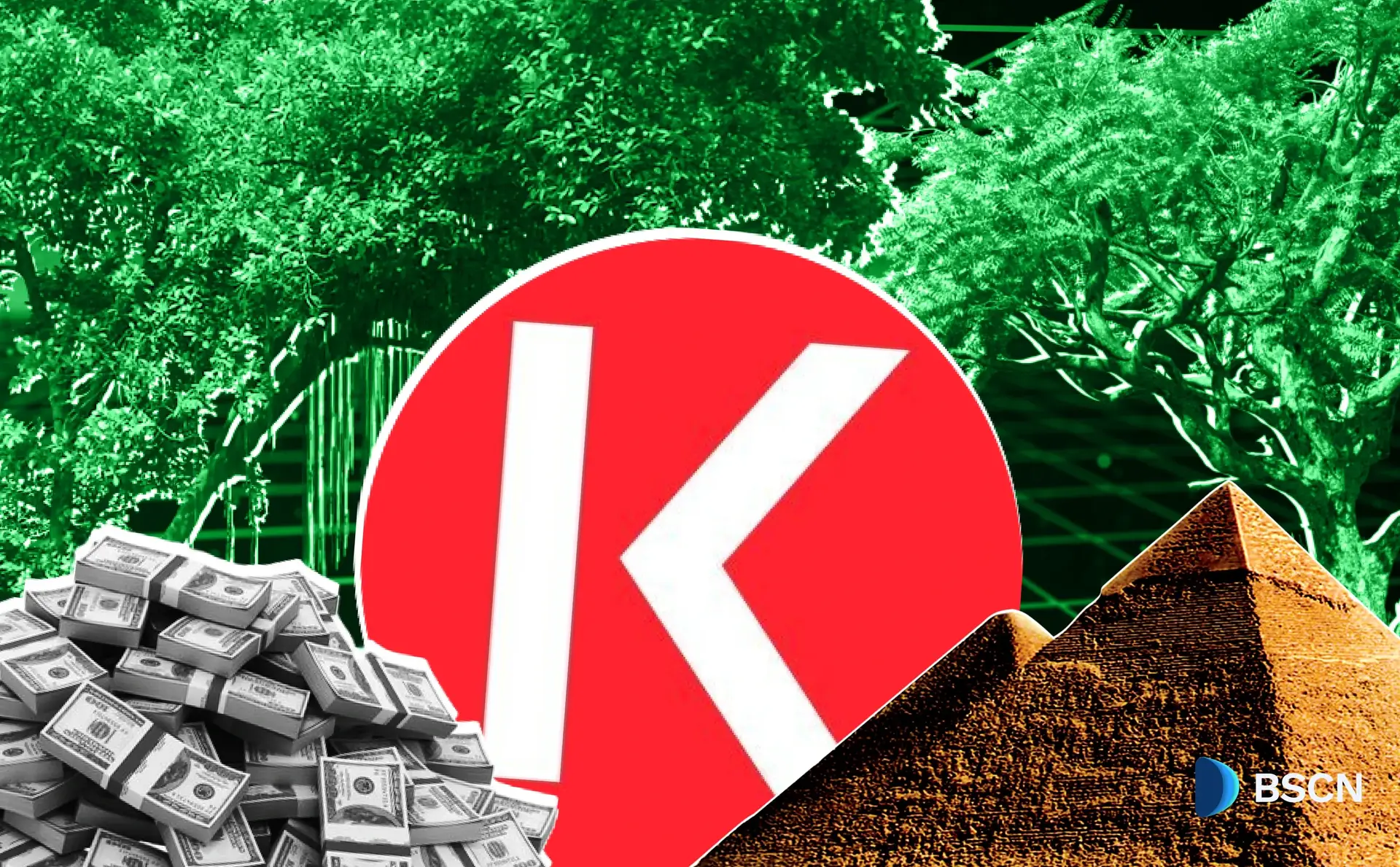
A comprehensive analysis of Kava's dual-chain architecture, tokenomics 2.0, and DeFi ecosystem. This deep dive explores how Kava integrates Ethereum and Cosmos capabilities to advance cross-chain interoperability.
Crypto Rich
April 2, 2025
(Advertisement)
Table of Contents
What is Kava?
Kava is a pioneering Layer-1 platform that uniquely bridges the Ethereum and Cosmos ecosystems. Its distinctive co-chain architecture grants developers and users simultaneous access to Ethereum's robust development tools and Cosmos's speed and interoperability advantages. With a mission to lead the world to Web3, Kava leverages its hybrid design to empower developers and users in a decentralized future.
The platform specializes in decentralized finance (DeFi) applications while supporting assets from multiple blockchains. By combining strengths from different ecosystems, Kava addresses common limitations that plague single-ecosystem networks, creating an integrated environment where developers can work with familiar tools while accessing cross-chain capabilities.
Kava's Evolution
Founded in 2017, Kava initially focused on cross-chain payment solutions before strategically shifting toward the emerging DeFi sector. The founding team—Brian Kerr, Ruaridh O'Donnell, and Scott Stuart—established crucial partnerships that accelerated adoption and development.
Key Historical Milestones
- November 14, 2019: Mainnet launch, transitioning from a Binance Chain-based token to a native Cosmos-based blockchain
- 2019: Introduction of Kava Mint for USDX stablecoin creation
- 2020: Implementation of Kava 3 upgrade with cross-chain lending via HARD Protocol
- 2021: Launch of Kava Swap, a cross-chain Automated Market Maker (AMM)
- 2022: Kava 11 upgrade brought liquid staking with bKAVA
- 2024: Achieved zero inflation with Tokenomics 2.0, establishing a hard-capped, proof-of-stake system
- February 2025: Launch of Kava AI with DeepSeek integration, enabling natural language interfaces for cross-chain transactions
Early backing from Ripple (through Xpring) and Binance (which named Kava its "Launchpad Project of the Year") provided critical momentum during Kava's formative period.
Technical Architecture: Kava's Dual-Chain Design
Co-Chain Architecture
What makes Kava stand out is its innovative dual-chain structure:
- Ethereum Co-Chain: Fully EVM-compatible, supporting Solidity smart contracts and familiar Ethereum development tools
- Cosmos Co-Chain: Built with the Cosmos SDK, delivering fast transactions and access to the Inter-Blockchain Communication (IBC) protocol
These chains operate in parallel and are connected by a translator module that ensures seamless interoperability. This architecture gives developers unprecedented flexibility—they can choose either environment based on their experience and project requirements.
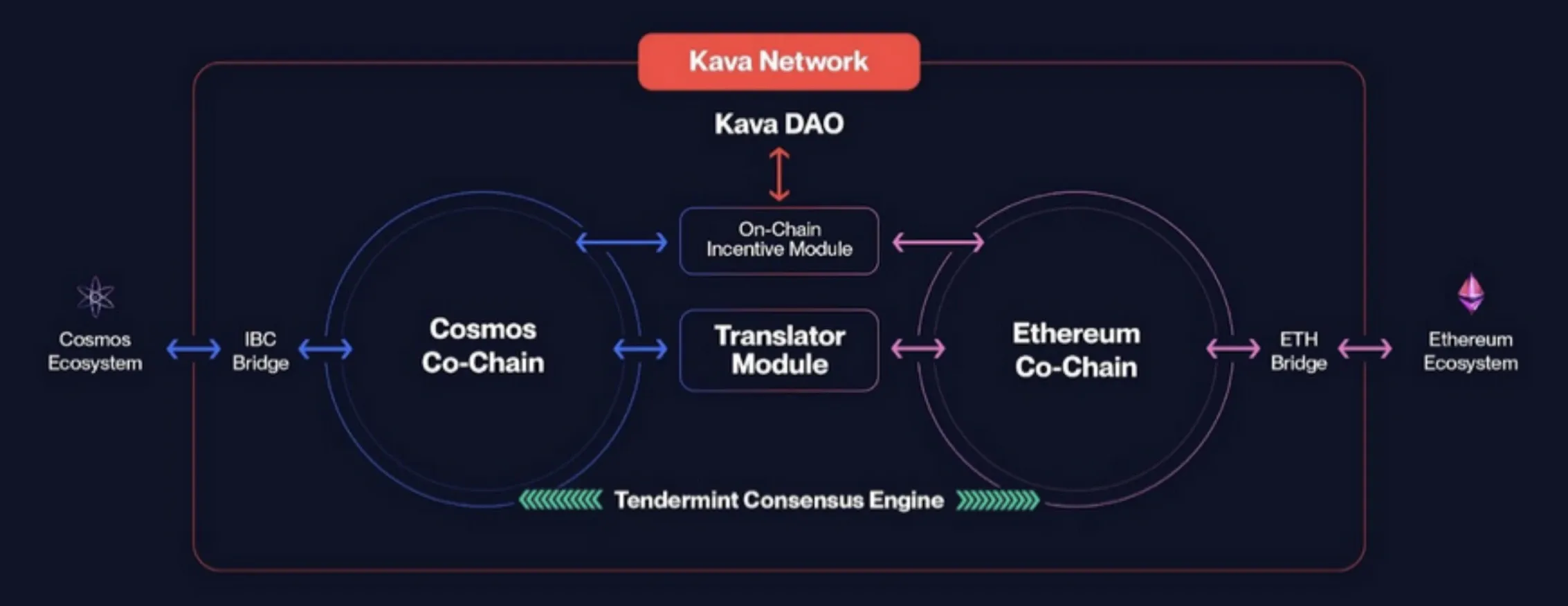
Consensus Mechanism and Security
At its core, Kava implements Tendermint, providing:
- Proof-of-Stake (PoS) consensus
- Single-block finality (transactions finalize in seconds)
- Capacity for thousands of transactions per second
- Byzantine Fault Tolerance for robust security
Network validators stake KAVA tokens to participate in block production, earning rewards while facing slashing penalties for downtime or rule violations. Regular users can also participate in network security without running validator nodes by delegating their KAVA tokens to trusted validators and earning a portion of the rewards. This two-tiered staking system creates strong incentives for network reliability while allowing broader participation in the network's economic model.
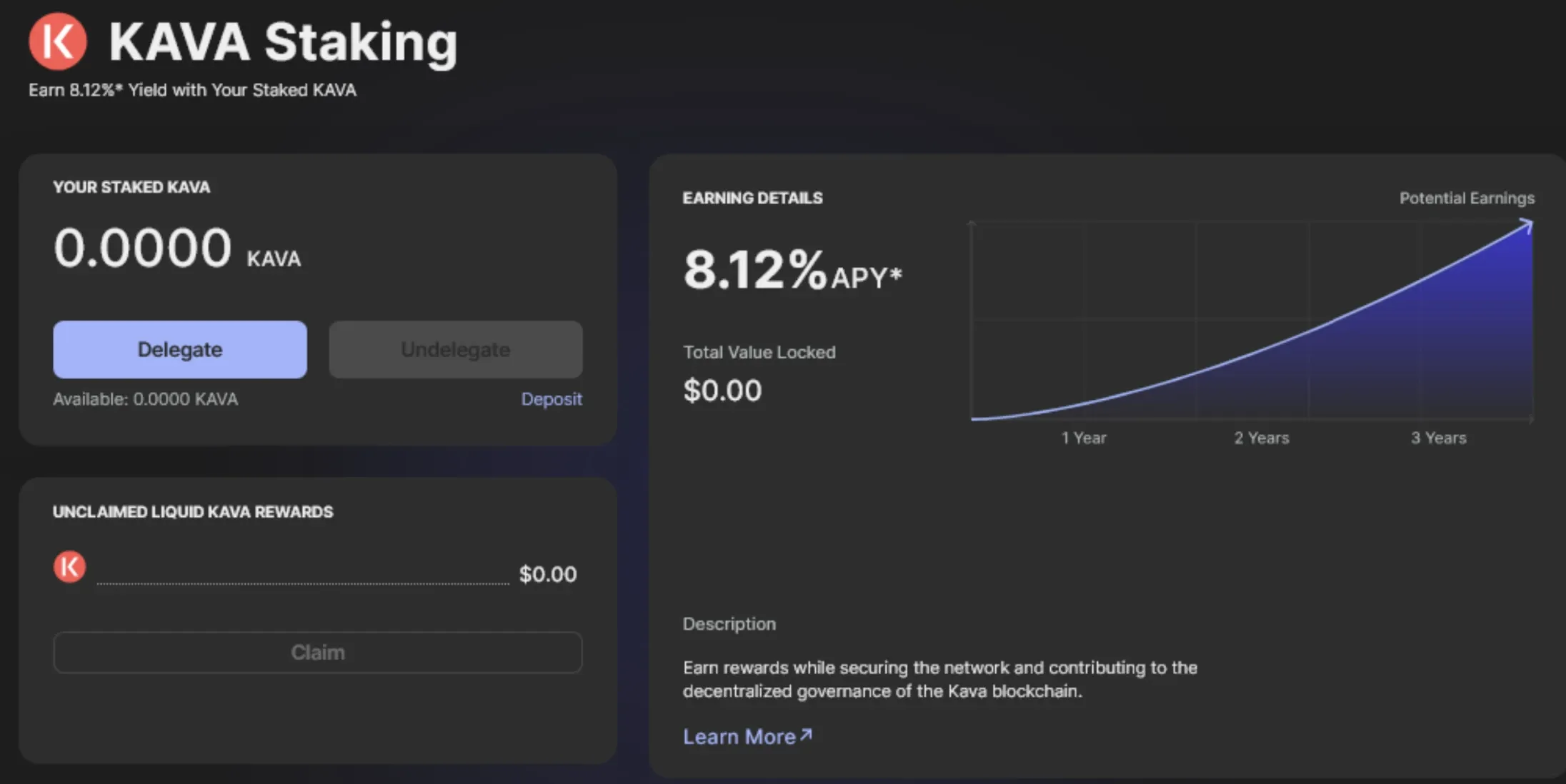
DeFi Capabilities on Kava
Kava has established a comprehensive DeFi platform with several key services:
Stablecoin Minting
Users can generate USDX, a USD-pegged stablecoin, by depositing supported cryptocurrencies as collateral. This over-collateralized approach aims to maintain stable value.
Cross-Chain Asset Support
Unlike platforms restricted to Ethereum-based assets, Kava supports transactions with assets from multiple blockchains, including:
- XRP
- Wrapped versions of Binance Coin (BNB)
- Ethereum (ETH)
- Cosmos (ATOM)
- Various wrapped versions of Bitcoin
A significant focus has been the integration of Tether (USDt) as a primary collateral asset. As the world's largest stablecoin, USDt brings substantial liquidity potential to Kava's ecosystem.
Lending and Borrowing
Through integrated protocols like HARD, users can lend assets to earn yields or borrow against their collateral across multiple blockchain assets—breaking free from single-ecosystem limitations.
Kava Swap (SWP Protocol)
Launched in 2021, Kava Swap functions as a cross-chain Automated Market Maker (AMM) that enables users to efficiently swap assets. The protocol is governed by the SWP token, which allows holders to participate in governance decisions and provide liquidity. As a major component of the Kava app alongside Mint and Lend functions, Kava Swap completes the platform's core DeFi offering by adding trading capabilities to its lending and stablecoin features.
Kava Swap particularly showcases the platform's cross-chain capabilities, allowing users to exchange assets that originate from different blockchain ecosystems through a single, unified interface.
Kava AI Applications
By early 2025, Kava AI introduced several groundbreaking applications that leverage artificial intelligence within DeFi:
- AI-driven flash loan strategies: Automated optimization of flash loan opportunities across multiple protocols
- Decentralized insurance with predictive models: Risk assessment and premium calculation based on on-chain data analysis
- Global lending automation: Cross-border lending platforms with AI-powered credit evaluation
- On-chain credit risk assessment: Real-time evaluation of borrower risk profiles using historical transaction data
- General-purpose AI chatbot: An interactive assistant that helps users with a wide range of questions both within and beyond the Kava ecosystem
These applications demonstrate how AI integration enhances DeFi functionality while maintaining decentralization principles.

Interoperability: Connecting Multiple Blockchains
Cosmos Ecosystem Integration
Kava connects to over 30 blockchains, including well known projects like Injective, Celestia and dYdX, in the Cosmos ecosystem through the Inter-Blockchain Communication (IBC) protocol. This connection enables seamless asset transfers and communications between Kava and other IBC-compatible chains.
Planned Blockchain Bridges
Kava's roadmap includes developing direct bridges to:
- Native BNB Chain (for direct BNB integration rather than wrapped tokens)
- Native Bitcoin (rather than wrapped versions)
- Additional EVM-compatible networks
These bridges aim to reduce fragmentation in the broader blockchain landscape, increasing asset compatibility and liquidity flows.
Developer Incentives: The Kava Rise Program
To foster innovation, Kava created the Kava Rise program:
- $750 million allocated to reward protocols building on the platform
- Rewards are distributed to top-performing protocols based on usage and TVL, leveraging this massive fund to drive a competitive, transparent developer ecosystem
- Support for developers using both Solidity and Cosmos SDK
This data-driven approach represents a departure from subjective grant programs, creating transparent incentives for meaningful development.
The KAVA Token: Economics and Utility
Token Functions
The KAVA token serves three essential functions:
- Governance: Stakers vote on network parameters, upgrades, and resource allocation
- Staking: Validators and delegators stake tokens to secure the network
- Network Security: The economic value of staked tokens creates a financial barrier to attacks
The token's utility extends across the entire Kava ecosystem, serving as the backbone of its security and governance models.
Tokenomics 2.0: Fixed Supply Model
January 2024 marked a pivotal economic shift for Kava:
- Zero inflation: All new token issuance halted
- Fixed supply: Approximately 1 billion KAVA tokens (1,082,853,474 KAVA)
- Industry first: The first decentralized PoS Layer-1 blockchain with a hard cap
This transition from an inflationary model (previously 3-20% based on staking ratios) to fixed supply represents a bold economic experiment in the Proof-of-Stake space.
Strategic Vault for Long-term Sustainability
To maintain validator incentives without inflation, Kava established a Strategic Vault. Funded by transaction fees and an initial community allocation, the Vault ensures sustainable rewards without inflating the fixed supply of 1 billion KAVA tokens. With over $300 million in community-owned assets, it provides sustainable rewards for network participants through transparent distribution governed by community decisions. This mechanism solves the sustainability challenges that typically face fixed-supply cryptocurrencies while preserving decentralized control.
Governance Structure: The Kava DAO
The Kava DAO functions as a fully decentralized autonomous organization governing the entire Kava Network. As a fully decentralized entity with no headquarters or central leadership, the Kava DAO uses liquid democracy—where stakers vote or delegate—to govern upgrades, parameters, and incentive allocation, ensuring community-driven growth.
The DAO determines all aspects of network function, including protocol upgrades, parameter changes, and—crucially—how to distribute on-chain developer incentives between the Ethereum and Cosmos co-chains. This allocation power gives the community direct control over ecosystem growth priorities.
The DAO also oversees Kava Swap via the SWP token, empowering users to govern the AMM protocol in a similar way that the HARD token governs the lending protocol. This multi-token governance approach allows specialized control over different aspects of Kava's DeFi ecosystem.
Those who contribute to the network's security and stability through staking and validation also provide its strategic direction, ensuring the network consistently serves the interests of both users and developers building on the platform.
Technical Implementation Details
Tendermint Consensus
Kava's implementation of Tendermint Core delivers significant advantages for users. Transactions reach finality in seconds rather than minutes, providing quick confirmation of operations. The system ensures high security through Byzantine Fault Tolerance, while Tendermint's Proof-of-Stake approach provides substantial energy efficiency compared to Proof-of-Work systems used by blockchains like Bitcoin.
Modular Upgrades
The Cosmos SDK framework that underpins Kava enables modular improvements without requiring disruptive hard forks. This architectural flexibility has allowed Kava to implement several significant upgrades smoothly, including IBC integration in 2022, which connected Kava to the broader Cosmos ecosystem. Other notable upgrades include the co-chain architecture that brought Ethereum Virtual Machine (EVM) compatibility and the recent Tokenomics 2.0 transition to a fixed supply model. This modularity ensures Kava can evolve continuously while maintaining network stability.
User-Friendly Tools
Kava offers several tools to improve accessibility. One notable example is the Kava AI Chatbot, a general-purpose interactive assistant that can help with a wide range of topics, including but not limited to the Kava ecosystem. Users can ask questions in natural language, and the chatbot provides responses to assist with their queries, making information more accessible regardless of technical expertise.
Security Measures
Kava maintains network integrity through a multi-layered security approach. The platform has historically undergone security audits from respected firms like CertiK and Quantstamp, which verify code reliability and identify potential vulnerabilities before they can be exploited. Critical smart contracts undergo formal verification, a rigorous mathematical process that proves code behaves exactly as intended under all circumstances. Additionally, economic security mechanisms via staking incentives ensure validators have financial motivation to maintain honest operation, as malicious behavior results in slashed stakes.
Ecosystem Development and Future Roadmap
Current Ecosystem Status
Kava now supports a thriving community of over 100 protocol development teams building various applications on its platform. A cornerstone of Kava's growth strategy is the integration of Tether (USDt) as a primary collateral asset. Through this USDt integration, the platform aims to onboard 10 million users to Cosmos DeFi—a goal that would represent major expansion and mainstream adoption of Kava's cross-chain capabilities.
In February 2025, Kava launched a major Kava AI upgrade, integrating a decentralized DeepSeek model to streamline cross-chain transactions with simple prompts. This development marked a significant leap in DeAI adoption, allowing users to interact with Kava's complex blockchain architecture through natural language processing.
2025 Roadmap Highlights
The platform's development plans focus on three key areas:
Decentralized AI (DeAI) Initiatives
- Oros: An AI agent layer automating blockchain functions
- OpenDiLoCo: Framework for decentralized AI model training
- DeepSeek integration: Expanding natural language interfaces for DeFi applications
These initiatives position Kava at the forefront of Decentralized Artificial Intelligence (DeAI), combining blockchain and AI technologies in novel ways.
Cross-Chain Expansion
- Layer 2 scaling solutions
- Integration with additional EVM-compatible networks
AI-Driven DeFi Automation
- Decentralized AI models for financial analysis
- Trusted Execution Environments (TEEs) for secure computation
Kava positions itself at the intersection of AI and DeFi—two rapidly evolving fields with transformative potential.
Conclusion: Kava's Position in the Blockchain Landscape
Kava has carved a unique niche by integrating Cosmos and Ethereum capabilities into a cohesive platform. Its dual-chain architecture overcomes the limitations of single-ecosystem networks while offering developers unprecedented flexibility.
The shift to a fixed-supply model represents a significant economic experiment in the PoS space, potentially offering an alternative to traditional inflationary approaches. Combined with community governance and the Strategic Vault mechanism, Kava demonstrates a balanced approach to decentralization and sustainability.
As the first hard-capped PoS Layer-1 and a pioneer in Decentralized AI, Kava offers a blueprint for sustainable, interoperable blockchain innovation. As blockchain technology evolves toward greater interoperability, Kava's cross-chain design and DeFi focus align it with industry momentum. The integration of AI capabilities further positions the platform to contribute to the next wave of blockchain innovation—creating a bridge not just between existing ecosystems, but toward emerging technologies as well.
For more information about Kava, visit their website, follow them on X, or interact with their general-purpose AI chatbot to get answers to your questions.
Read Next...
Disclaimer
Disclaimer: The views expressed in this article do not necessarily represent the views of BSCN. The information provided in this article is for educational and entertainment purposes only and should not be construed as investment advice, or advice of any kind. BSCN assumes no responsibility for any investment decisions made based on the information provided in this article. If you believe that the article should be amended, please reach out to the BSCN team by emailing [email protected].
Author
 Crypto Rich
Crypto RichRich has been researching cryptocurrency and blockchain technology for eight years and has served as a senior analyst at BSCN since its founding in 2020. He focuses on fundamental analysis of early-stage crypto projects and tokens and has published in-depth research reports on over 200 emerging protocols. Rich also writes about broader technology and scientific trends and maintains active involvement in the crypto community through X/Twitter Spaces, and leading industry events.
(Advertisement)
Latest News
(Advertisement)
Crypto Project & Token Reviews
Project & Token Reviews
Comprehensive reviews of crypto's most interesting projects and assets
Learn about the hottest projects & tokens
Latest Crypto News
Get up to date with the latest crypto news stories and events





